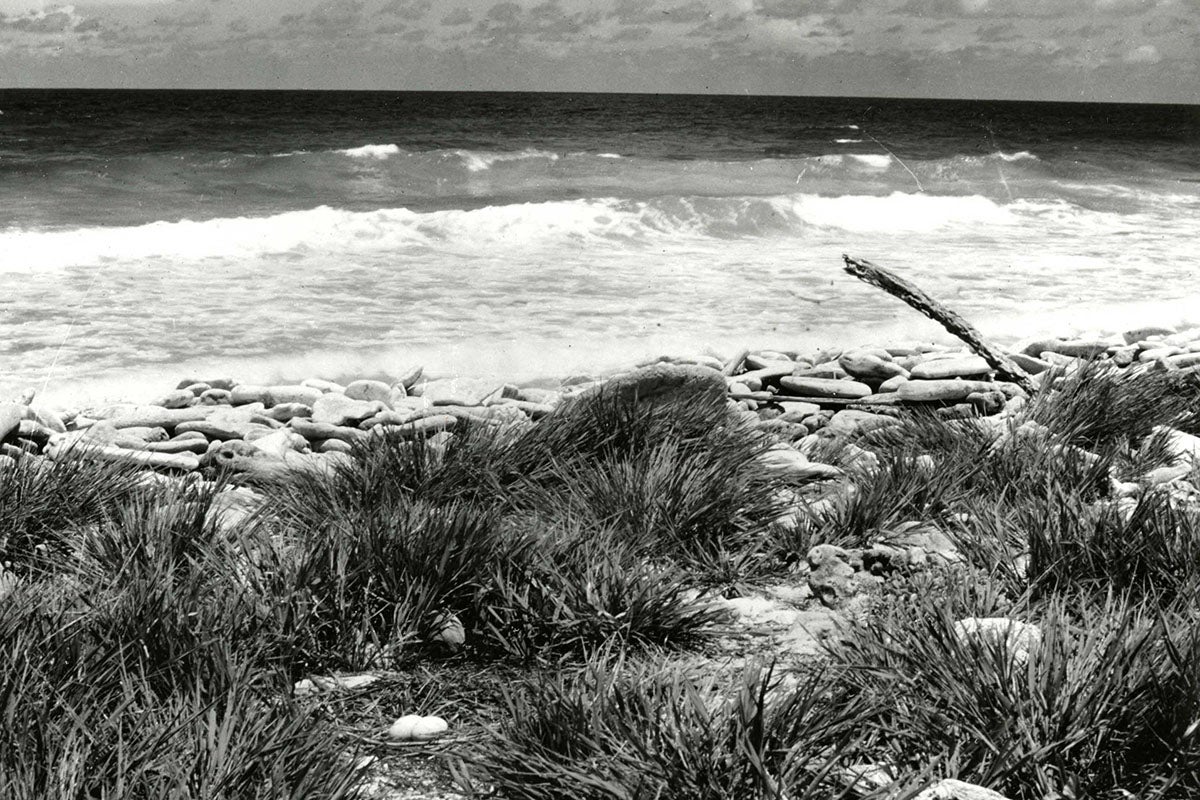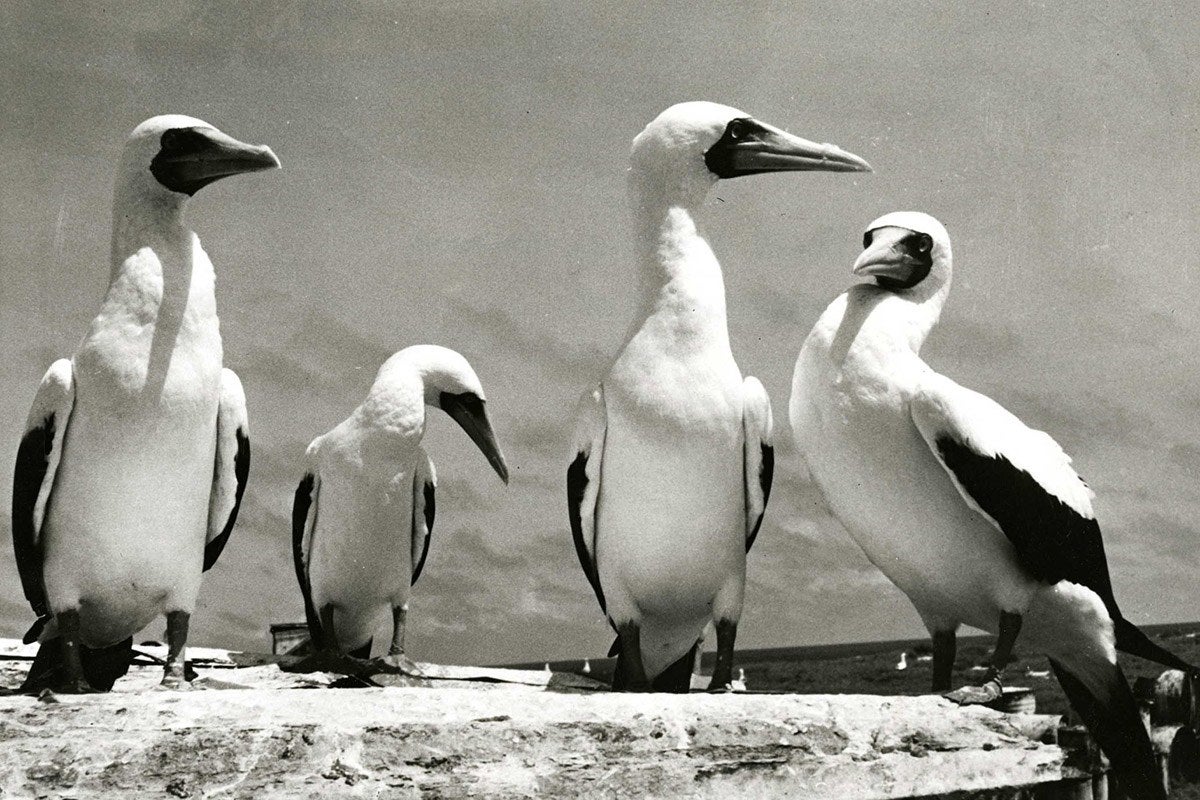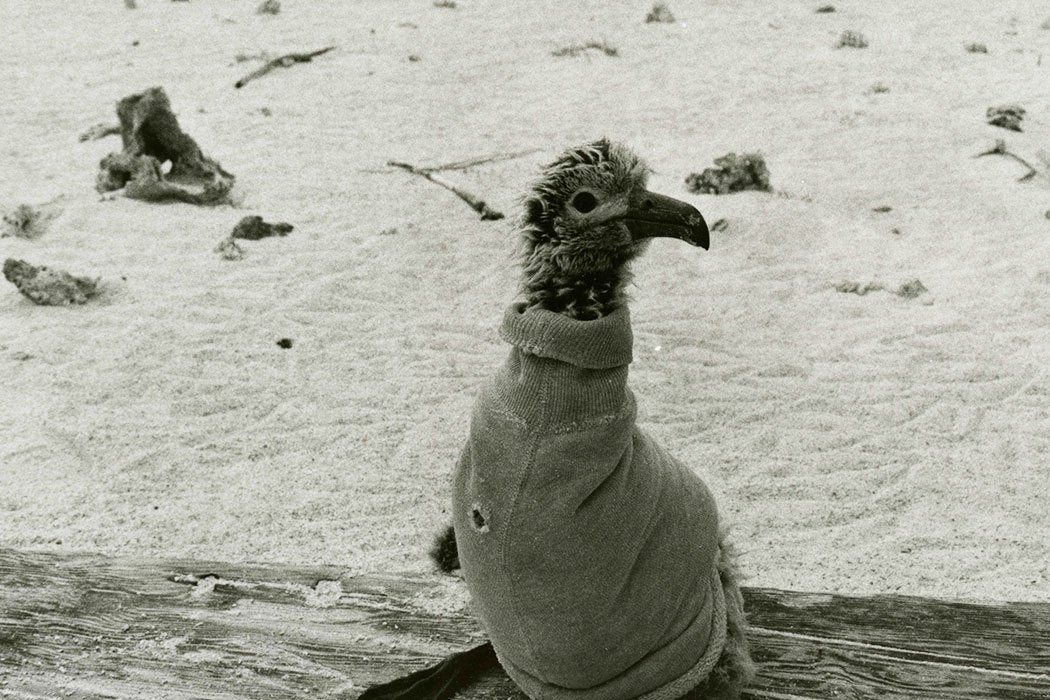I’m staring at a box labeled “Fish Eyeballs.” The crumpled, colorless balls of dried-out flesh inside don’t look especially fishy, let alone eyeball-like. Each is confined to its own glass jar, and they rattle like macabre maracas when I move the box.
Beneath my feet, the marble halls of the Smithsonian Natural History Museum teem with tourists immersed in video displays or taking selfies as Neanderthals. By contrast, this section of the attic feels like a scientific time capsule. Hand-drawn maps are stored in cubbies; card catalogs hold lists of references. Dr. Autumn-Lynn Harrison—research ecologist at the Smithsonian Migratory Bird Center, and my guide for the day—kneels on the floor beside me, sorting through a file drawer of computer punch cards. The punch cards contain extensive data on sightings of birds and mammals, cross-referenced with locations and environmental conditions. A dusty quiet, unique to archives, envelops the room.
We’ve come in search of records of a little-known expedition called the Pacific Ocean Biological Survey Program (POBSP; this replaced the original name, Pacific Ocean Ornithological Project, when someone stopped to consider acronyms). From 1962 to 1969, over seventy scientists and graduate students traveled to U.S. outlying islands in the Pacific Ocean to band birds, conduct surveys, inventory flora and fauna, and collect samples. This attic holds only a small fraction of the project materials in the Smithsonian’s collections, which encompass over 234 boxes and range from specimens to a never-filmed movie script (“Guano Hell: Or, the Roar of the Gore”).
POBSP contributed an incredible amount of information on the ecology of marine birds and of tiny, barely-studied islands. Topics range from seabirds, to dolphins, to skinks, to parasites, to missing islands. Nearly two million birds were banded over the course of eight field seasons. The researchers developed new analytical techniques to handle the vast quantities of information, and there may be more still to come. Harrison, who has spent over a decade studying the movements of marine birds and mammals in the Pacific, is especially fascinated by the project’s detailed records of banded and recaptured seabirds. “They recorded so much information on mortalities, even the nationality of the ships,” she says, showing me an example of a bird found caught by a Japanese tuna fishing vessel. “A lot of this has never been fully analyzed,” she says. Harrison hopes to draw scientific interest in the project, potentially re-creating some of the original surveys to assess how seabird communities have changed since the study.
The information collected by the study was unprecedented, and yet, after eight years, with several projects still ongoing, the data abruptly end. Alongside the scientific story of the POBSP is a more human story, one that remains a controversial chapter in the Smithsonian’s long history.
* * *
Smithsonian archivist Lesley Parilla, who coordinates the Field Book Project, knows the story of the rise and fall of the Pacific Ocean Biological Survey more intimately than almost anyone else. She’s archived stacks of handwritten notes from the program scientists, and credits more of the notebooks in her collection to the POBSP than to any other single project. She is fascinated by their voices and group dynamics, which come to life in their writings. “One guy was the innocent of the group, so they gave him an erotic novel to read without telling him what it was. That kind of thing.” For Parilla, the notebooks are the human face of science.
In a conference room near her office, Parilla shows us the personnel folders. We shuffle through stacks of passport photos of clean-cut young men, invariably white, with mid-century haircuts. The same men also appear in field photos, shirtless and swaggering like cowboys as they straddle albatrosses to band them. As a seabird biologist, I can identify with living on remote islands and been bitten and vomited on by disgruntled birds, yet this work seems foreign even to me. Looking at the photos reminds me of listening to senior scientists at conferences wax poetic about the days when seabird biology was a rugged world of risk and adventure, charismatic men living in tents at the ends of the earth with little regard for the dangers of their work. I can’t help but feel vaguely nostalgic for this world, one I’ve never experienced and in which I wouldn’t have been welcome. There’s an appealing innocence about it.

When we get to the folder labeled “Publicity, 1969-1970,” though, that innocent feeling abruptly disappears. The press clippings in the folder read like excerpts from a bizarre spy novel: “Are bird watchers helping germ warfare research?” “Under guise of Pacific bird study, army plans for biological warfare reported.” The entire project—Parilla explains—was based on a Faustian bargain with the military. In exchange for funding the POBSP, whose biologists were only too eager for the opportunity to study places where little research had been conducted, the military requested basic information on the movements of birds. It seemed a relatively minor price, and one that wasn’t uncommon in the history of either agency. The official reason for the study, written up in contracts, was to conduct a baseline survey. It’s unclear whether the scientists involved in the project ever had reason to doubt this story. The only unusual component was a request for avian blood samples, to be delivered to the top-secret Army Chemical Center, at Fort Detrick, Maryland.
Suspicions were eventually raised in the Senate Foreign Relations Committee, and in 1969 the committee revealed a year-long investigation into the POBSP. In fact, the project ran simultaneously with the highly classified Pacific Project, a cold-war era study assessing the viability of germ warfare. Although there is no concrete evidence linking the two projects, it’s hard not to see the military’s sudden interest in seabird movements as suspicious. Wide-raging seabirds could potentially transport zoonotic diseases thousands of miles from their release site. Understanding their movement patterns, and whether they carried the pathogens being tested, would be crucial to understanding how to target biological weapons attacks. Although these suspicions could never be proven, the unexplained delivery of blood samples to an army base, for purposes that were highly classified, cast doubt on the Smithsonian’s role as a neutral scientific organization.
“The Smithsonian doesn’t deal with classified information,” Parilla tells me. “We never have, but this project deviated from that policy, in part because of the political atmosphere at the time. It’s the main cautionary tale we can use to explain why this policy is so important.”
It’s hard to reconcile the innocuous files in the attic—fish eyes, punch cards, survey routes, all routine scientific study and inventory—with the kind of clandestine operation implied by the Senate committee’s investigation. Collecting blood samples for Fort Detrick might have seemed like a minor, relatively harmless exchange for the valuable data the scientists gained. In fact, it threw the project into suspicion and provoked a period of soul-searching at the Smithsonian. In Parilla’s view, the downfall of the POSBP is less a story of sinister collusion between science and the military than it is a cautionary tale about the importance of transparency. “There was a lot of funding. The researchers saw the scientific opportunities that came with the money, but not necessarily the consequences.”

For some, those consequences may have been personal as well as professional. Biologist Mark Rauzon, who spent many years studying documents related to the Pacific Project, has come to understand that the scientists themselves may have been guinea pigs for defense tests. Over fifty germ warfare tests were conducted in the Pacific during the 1960s, with substances ranging from harmless bacteria to rabbit fever. In the course of the tests, passengers on Pacific Project ships, which transported both military personnel and associated biologists, were exposed to harsh chemical cleansers, and the “harmless” bacteria have since been linked to a variety of debilitating conditions. Veterans who suffered adverse effects have been unsuccessful in requesting government compensation. Though no POBSP personnel have reported health effects, many may have been exposed. Rauzon’s efforts led to the release of many of the military’s documents related to the project, but complete records may never be provided.
* * *
Was it worth it? On one hand, the published articles, and the attic’s treasure trove of data, never would have been possible without the military’s support. Collected before sea level rise and ocean acidification changed the face of low-lying Pacific islands, they provide an invaluable baseline for future study. Nevertheless, it’s difficult to recover from the shadow of a sinister conspiracy theory. As public funds for pure scientific research, already scarce, continue to be reduced, scientists are forced to turn to agencies and individuals whose interests may not be purely scientific. We take careful steps to maintain our neutrality and integrity, or so we believe. The tale of the POBSP is a sobering reminder that, sometimes, that isn’t enough.
Even knowing how the project ended, I can’t help seeing the optimistic side embodied by those photos of grinning young scientists, surrounded by birds, alive and fortunate and looking as if they, too, could levitate. In the attic, Harrison finds the movie script stashed in a bottom drawer, and together we read the bittersweet ending: “An end to mung and barf-stained clothes, a cease to climbing trees, getting out on dead limbs and knocking boobies off their evening perch with a pole, hoping it will only land in shark-infested waters, then wade out to grab the angry, hungry bird to band it. Back to civilization and the serenity of an ornithologist in the bird lofts of the world. Back from Guano Hell.”







